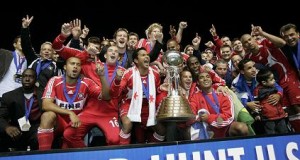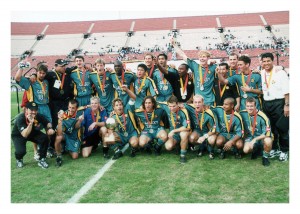 Every year when the Lamar Hunt US Open Cup tournament rolls into the lights shining down onto the stadium pitch, the inevitable comparisons to the FA Cup in England come into play as part of the explanation to what the tournament is for journalists. And often times it’s followed by the unfortunate analogizing of the event to minor and major league baseball teams playing one another in a single-elimination tournament.
Every year when the Lamar Hunt US Open Cup tournament rolls into the lights shining down onto the stadium pitch, the inevitable comparisons to the FA Cup in England come into play as part of the explanation to what the tournament is for journalists. And often times it’s followed by the unfortunate analogizing of the event to minor and major league baseball teams playing one another in a single-elimination tournament.
But perhaps the better comparisons we should all be making is to the other Opens in which the American media already treat as serious events. These events also pit amateurs versus professionals on an open entry basis, and are also among numerous events within the specific sport. These events, of course, are the US Open tennis tournaments held annually in New York and the US Open golf championship held in a different location each year around the United States.
Each fall, the world’s best tennis players convene on the hard courts of the USTA’s Billy Jean King National Tennis Center in Queens, NY for the tour’s fourth and final major of what the sport considers the Grand Slam. Those top-flight professionals are joined by winners of an open playoff system that is comprised 16 sectionals and a national playoff event in which only USTA members may participate. In the end, 128 participants each take part in the men’s and women’s brackets (64 for doubles).
Last year, over 1,200 players took part in the USTA’s National Playoffs for a chance to compete in the singles events at the US Open. Unlike US Soccer’s Open Cup, only one male and one female earned qualification spots to compete against the world’s best in the tournament.

The US Open golf tournament, held in June, is comparatively more open with approximately half the participants advancing from qualification play to join the world’s top players who are automatically in the field through 17 exemptions categories via such things as being tournament winners or holding a certain world ranking.
At the 2010 tournament, 75 of the 156 participants were non-exempted players who qualified through the two-stage process to reach the famed Pebble Beach Golf Links for the championship. The process begins with Local Qualifying, a series of over 100 18-hole tournaments held around the country. Many top players not already qualified through full exemption are, however, exempt from local qualifying and join the process at the Sectional Qualifying stage where they participate in one of several one-day, 36-hole tournaments in the United States. There is also a Sectional tournament in both Europe and Japan where 11 and 4 individuals qualified, respectively, in 2010.
The major difference between the US Open Cup and the US Open tennis and golf duo is that the US Soccer Federation event is the only one that is a championship tournament for Americans while the other two are open to foreign participants. The only clubs eligible for the US Open Cup are American-based teams that are affiliated through the USSF; however, for argument’s sake it does still feature a foreign component as teams are comprised, in part, of players that are not American.

Continuing on the golf tangent, another significant open tournament American media and sports fans are very familiar with and follow every July is the British Open (officially known as The Open Championship), which is the oldest of the four golf majors and is the only one held outside of the United States. Similar to the US Open, the majority of the 156 participants are automatic entrants through exemption with the remaining players advancing from a two-stage qualification process.
Through 2004, players from around the world were only able to qualify through 18-hole Local Qualifying events held around Britain and Ireland within two weeks of The British Open followed by 36-hole Local Final Qualifying tournaments a few days later. International Qualifying events, 36-hole tournaments, were added in 2004 to assist foreign professionals wishing to participate, holding qualifiers in Africa, Australia, Asia, America and Europe with more stringent entrance standards than Local Qualifying.
Packaging & Marketing US Soccer Majors
The golf and tennis tours are lengthy seasons that run from January to the fall with tournament events nearly every week, but it is the majors where media coverage amps up and fan viewership heightens. With the similarities of the American Open majors to the US Open Cup, perhaps there are other lessons to be learned from the golf and tennis tours, such as the incorporation US Soccer Majors as a marketing tool for the sports’ leading championship events for American clubs.
A matching structure of four championships already exists with the US Open Cup joined by the MLS Cup, MLS Supporters’ Shield (regular season championship) and the CONCACAF Champions League. Currently, the MLS Cup is the leading championship, but by creating a platform that raises the perception of the other three events to a comparable level to the league’s championship playoff, it will increase awareness among the media and fans while also, hopefully, creating a greater sense of seriousness and urgency to win the other events among the clubs and coaches.
Bringing these four championships together into one packaged series allows for a greater ability to compare the success of clubs beyond just winning MLS Cup as though this was the NFL and the Super Bowl while clubs around the rest of the world are evaluated on all the various events in which they participate. It would be similar to how tennis players and golfers are measured by majors won.

For instance, the Los Angeles Galaxy and DC United are the only two clubs that have won all four majors (dating back to the CCL precursor CONCACAF Champions Cup). In fact, the two also hold the most total majors with DC boasting 11 (4 MLS Cups, 4 Supporters’ Shields, 2 Open Cups and a CCC) and the Galaxy having eight (2 MLS Cups, 3 Supporters’ Shields, 2 Open Cups and the CCC).
Only five clubs have won all three of the domestic majors with the Chicago Fire, Columbus Crew and Sporting Kansas City having won everything but a CONCACAF championship at least once. The Fire are third in total majors (6) and the Crew are fourth (5).
Only three American MLS clubs are without a major championship, excluding expansion Portland. The New York Red Bulls, Chivas USA and Philadelphia Union have yet to claim one of the big prizes.
In the last five years, the most successful clubs in the United States have been Columbus and DC, each having won three majors. The Crew have won the Supporters’ Shield twice and the MLS Cup once. DC also has two Supporters’ Shields, but has a US Open Cup championship to round things out. Houston and Seattle each have two titles with the Dynamo winning MLS Cup twice in a row and the Sounders taking the Open Cup title back-to-back. Five other teams each have one major as nine clubs have won the 15 possible domestic majors while coming up empty in the Champions League, which is completing its third run with Real Salt Lake still in the hunt for a second major in the same cycle in which it won the MLS Cup title and qualified for the event.
All-Time ‘US Soccer Majors’ Winners List
11 – DC United (4 MC, 4 SS, 2 OC, 1 CCC)
8 – Los Angeles Galaxy (2 MC, 3 SS, 2 OC, 1 CCC)
6 – Chicago Fire (1 MC, 1 SS, 4 OC)
5 – Columbus Crew (1 MC, 3 SS, 1 OC)
3 – San Jose Earthquakes (2 MC, 1 SS)
3 – Sporting Kansas City (1 MC, 1 SS, 1 OC)
2 – Houston Dynamo (2 MC)
2 – Seattle Sounders (2 OC)
1 – Colorado Rapids (MC), FC Dallas (OC), Real Salt Lake (MC), New England Revolution (OC), Rochester Rhinos (OC), Tampa Bay Mutiny (SS), Miami Fusion (SS)
(MC – MLS Cup, SS – Supporters’ Shield, OC – US Open Cup, CCC/CCL – CONCACAF Champions Cup/League)